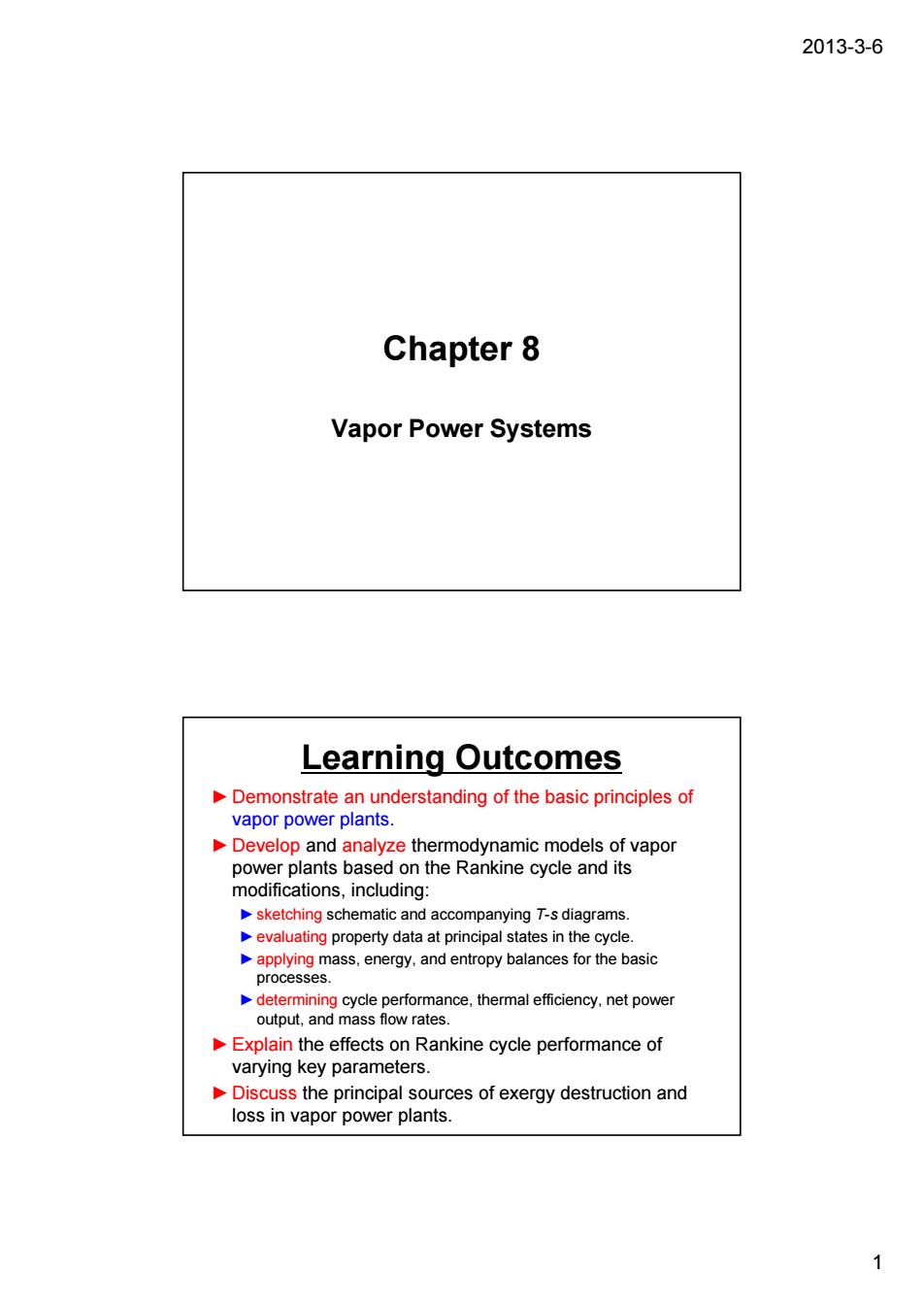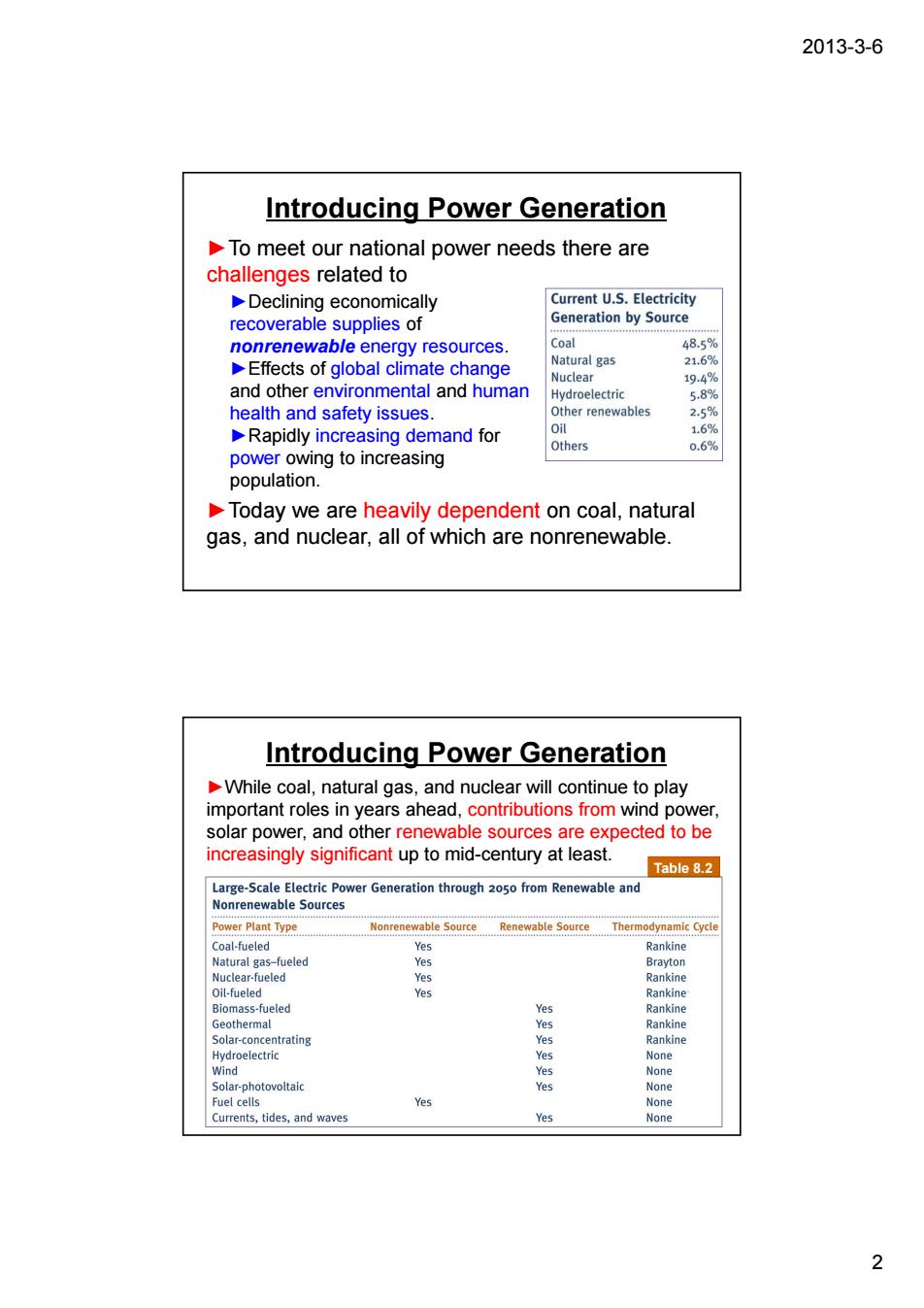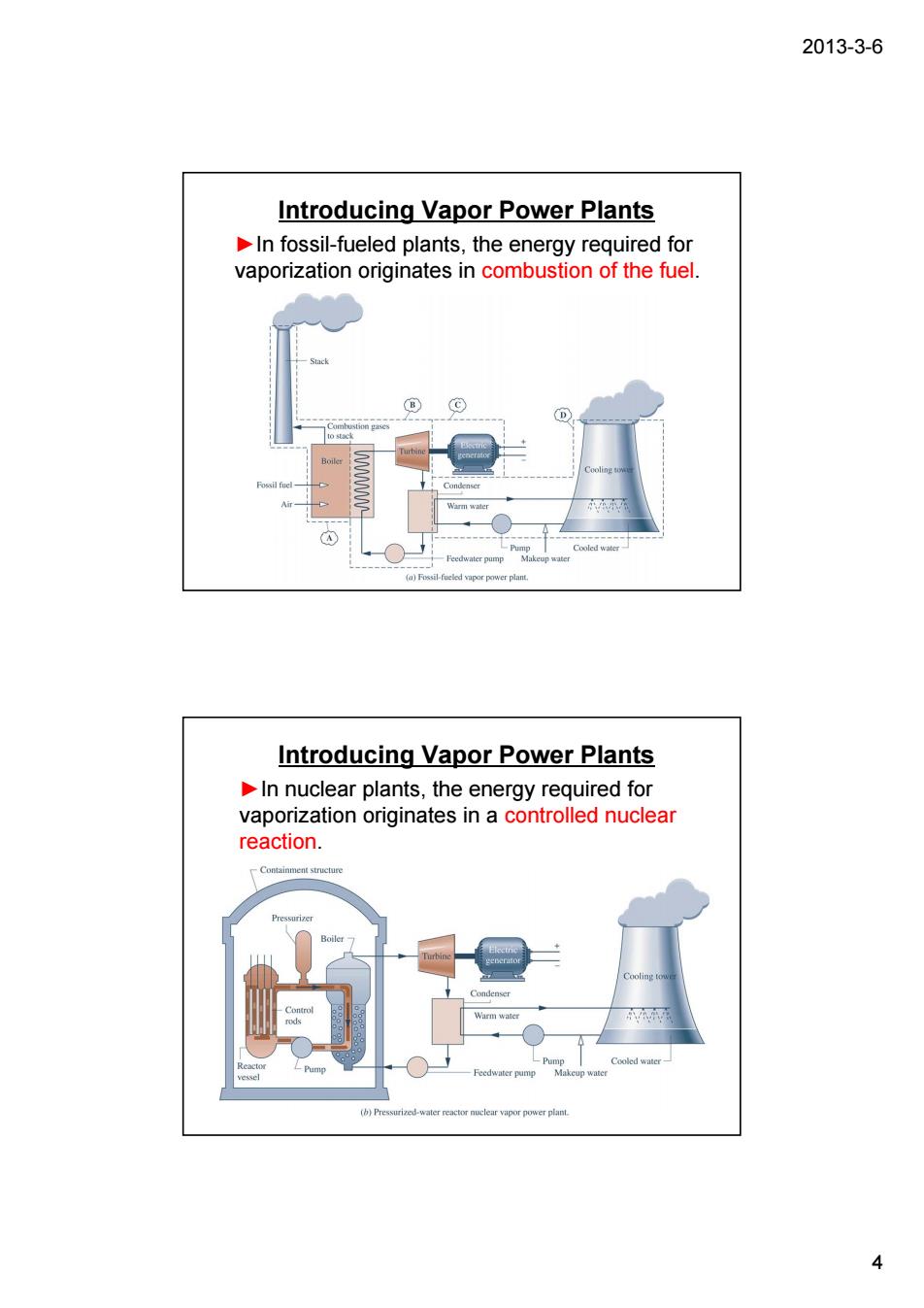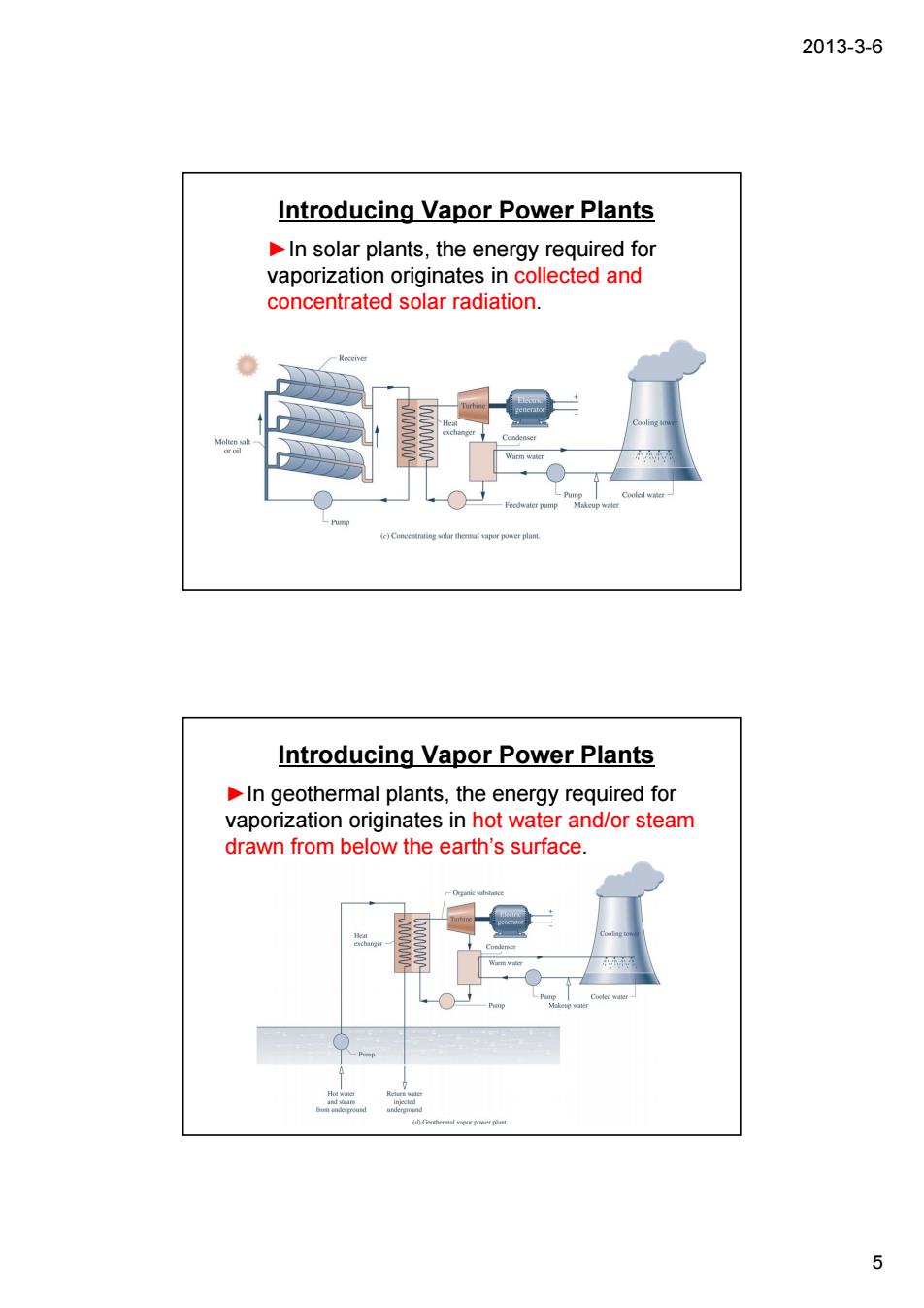
2013-3-6 Chapter 8 Vapor Power Systems Learning Outcomes Demonstrate an understanding of the basic principles of vapor power plants. Develop and analyze thermodynamic models of vapor power plants based on the Rankine cycle and its modifications,including: npropery data at prinpain thye. y determining cycle performance,thermal efficiency.net power output,and mass flow rates. Explain the effects on Rankine cycle performance of varying key parameters. s the principal sources of exergy destruction and
2013-3-6 1 Chapter 8 Vapor Power Systems Learning Outcomes ►Demonstrate an understanding of the basic principles of vapor power plants. ►Develop and analyze thermodynamic models of vapor power plants based on the Rankine cycle and its modifications, including: ►sketching schematic and accompanying T-s diagrams. ►evaluating property data at principal states in the cycle. ►applying mass, energy, and entropy balances for the basic processes. ►determining cycle performance, thermal efficiency, net power output, and mass flow rates. ►Explain the effects on Rankine cycle performance of varying key parameters. ►Discuss the principal sources of exergy destruction and loss in vapor power plants

2013-3-6 Introducing Power Generation To meet our national power needs there are challenges related to Declining economically Current U.S.Electricity recoverable supplies of eration by Sour nonrenewable energy resources. Coal al gas 48.5 Effects of global climate change and other environmental and human ectric health and safety issues. Other renewables Rapidly increasing demand for power owing to increasing Others population. Today we are heavily dependent on coal,natural gas,and nuclear,all of which are nonrenewable. Introducing Power Generation While coal,natural gas,and nuclear will continue to play important roles in years ahead,contributions from wind power solar power,and other renewable sources are expected to be increasingly significant up to mid-century at least. Table 8.2 LacaleEectric Powerrioufrom Renewable and wable Source Renewable Source oal-fueled electric Yes 2
2013-3-6 2 Introducing Power Generation ►To meet our national power needs there are challenges related to ►Today we are heavily dependent on coal, natural gas, and nuclear, all of which are nonrenewable. ►Declining economically recoverable supplies of nonrenewable energy resources. ►Effects of global climate change and other environmental and human health and safety issues. ►Rapidly increasing demand for power owing to increasing population. Table 8.2 Introducing Power Generation ►While coal, natural gas, and nuclear will continue to play important roles in years ahead, contributions from wind power, solar power, and other renewable sources are expected to be increasingly significant up to mid-century at least

2013-3-6 Introducing Power Generation Table 8.2 also shows that thermodynamic cycles are a fundamental aspect of several power plant types that employ renewable or nonrenewable sources. In Chapters 8 and 9.vapor power systems,gas turbine power systems,and internal combustion engines are studied as thermodynamic cycles. Vapor power systems in which a working fluid is alternately vaporized and condensed is the focus of Chapter 8.The basic building block of vapor power systems is the Rankine cycle. Introducing Vapor Power Plants The components of four alternative vapor power plant configurations are shown schematically in Fig 8.1.They are Fossil-fueled vapor power plants. Pressurized-water reactor nuclear vapor power plants. Concentrating solar thermal vapor power plants Geothermal vapor power plants. In each of the four types of vapor power plant,a working fluid is alternately vaporized and condensed A key difference among the plants is the origin of the energy required to vaporize the working fluid. 3
2013-3-6 3 Introducing Power Generation ►Table 8.2 also shows that thermodynamic cycles are a fundamental aspect of several power plant types that employ renewable or nonrenewable sources. ►In Chapters 8 and 9, vapor power systems, gas turbine power systems, and internal combustion engines are studied as thermodynamic cycles. Vapor power systems in which a working fluid is alternately vaporized and condensed is the focus of Chapter 8. The basic building block of vapor power systems is the Rankine cycle. Introducing Vapor Power Plants ►The components of four alternative vapor power plant configurations are shown schematically in Fig. 8.1. They are ►Fossil-fueled vapor power plants. ►Pressurized-water reactor nuclear vapor power plants. ►Concentrating solar thermal vapor power plants. ►Geothermal vapor power plants. ►In each of the four types of vapor power plant, a working fluid is alternately vaporized and condensed. A key difference among the plants is the origin of the energy required to vaporize the working fluid

2013-3-6 Introducing Vapor Power Plants In fossil-fueled plants,the energy required for vaporization originates in combustion of the fuel. Fail-fuled vapor pover pr Introducing Vapor Power Plants In nuclear plants,the energy required for vaporization originates in a controlled nuclear reaction. 4
2013-3-6 4 Introducing Vapor Power Plants ►In fossil-fueled plants, the energy required for vaporization originates in combustion of the fuel. Introducing Vapor Power Plants ►In nuclear plants, the energy required for vaporization originates in a controlled nuclear reaction

2013-3-6 Introducing Vapor Power Plants In solar plants,the energy required for vaporization originates in collected and concentrated solar radiation. Introducing Vapor Power Plants In geothermal plants,the energy required for vaporization originates in hot water and/or steam drawn from below the earth's surface. 5
2013-3-6 5 Introducing Vapor Power Plants ►In solar plants, the energy required for vaporization originates in collected and concentrated solar radiation. Introducing Vapor Power Plants ►In geothermal plants, the energy required for vaporization originates in hot water and/or steam drawn from below the earth’s surface